Front Page
Gallery
Digital
Television
Widescreen TV
Radio
Movies
Links
Guestbook
E-mail Me
Main Index
Widescreen TV
Whilst Widescreen and Digital do not necessarily go hand in hand, the availability of widescreen programmes has increased and so I have put my widescreen page in this section.
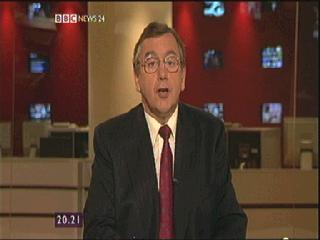 Widescreen broadcasts are transmitted via digital as conventional 4x3 pictures, except the are squeezed into a 4:3 shape and transmitted with a flag to say that the picture is widescreen so that the proportions can be corrected to 16x9 on the TV screen. The picture to the left is from BBC News 24, and I will use it to demonstrate how digital widescreen works.
Widescreen broadcasts are transmitted via digital as conventional 4x3 pictures, except the are squeezed into a 4:3 shape and transmitted with a flag to say that the picture is widescreen so that the proportions can be corrected to 16x9 on the TV screen. The picture to the left is from BBC News 24, and I will use it to demonstrate how digital widescreen works. The picture can be displayed in one of two ways on a 4x3 TV. The digital box or integrated TV horizontally, with the left and right extremities chopped off to give a picture in the correct proportions which fills the screen, as shown below left. Or, it can be squashed vertically, resulting in thick black bars top and bottom as shown below right:
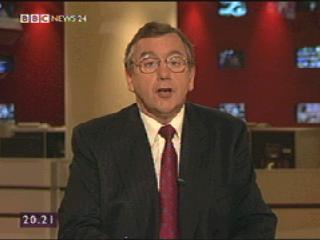 | 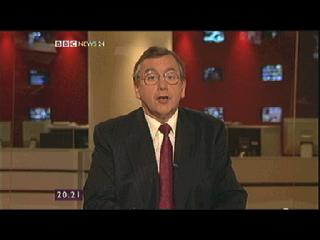 |
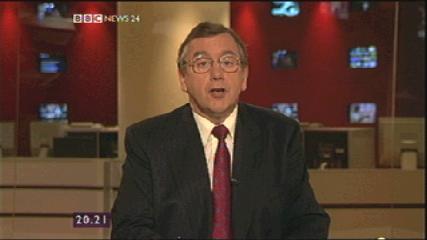 If you have a widescreen TV, you can view the whole picture without any black bars. In this case, the Tv does the streching. It will automatically switch to its 'wide' or 'full' mode when it gets a signal through the SCART cable from the digital box:
If you have a widescreen TV, you can view the whole picture without any black bars. In this case, the Tv does the streching. It will automatically switch to its 'wide' or 'full' mode when it gets a signal through the SCART cable from the digital box:News 24 is also broadcast on cable and overnight on BBC ONE. In the analogue versions, only a 4:3 frame is available, so the picture is converted by the BBC to 14x9 letterbox - it chops of some of the sides but also uses thinner black bars top and bottom to produce the desired picture:
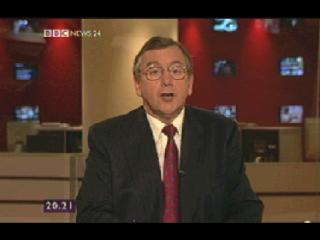 This method is used for many widescreen programmes for broadcasting on analogue. This is considered a compromise between displaying the picture in either the 16x9 deeper letterbox or 4x3, which would lose too much of the picture. This however, causes a problem for people with some makes of widescreen TVs.
This method is used for many widescreen programmes for broadcasting on analogue. This is considered a compromise between displaying the picture in either the 16x9 deeper letterbox or 4x3, which would lose too much of the picture. This however, causes a problem for people with some makes of widescreen TVs.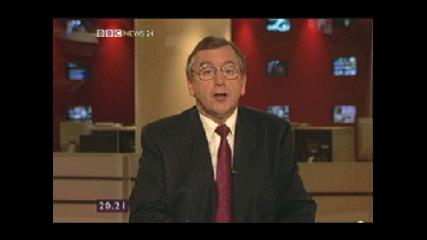 Those who have a 14x9 zoom mode, can watch the picture with thin black bars left and right. The TV adds these bars to turn a 14x9 image (albeit within a 4x3 frame) into a 16x9 one. Many makes of Widescreen TV do not have this mode, and may be limited to two options - adding thick black bars left and right, which result in a black surround (shown left) or zooming in so that there are no black bars but some of the top and bottom of the image is lost, as below:
Those who have a 14x9 zoom mode, can watch the picture with thin black bars left and right. The TV adds these bars to turn a 14x9 image (albeit within a 4x3 frame) into a 16x9 one. Many makes of Widescreen TV do not have this mode, and may be limited to two options - adding thick black bars left and right, which result in a black surround (shown left) or zooming in so that there are no black bars but some of the top and bottom of the image is lost, as below: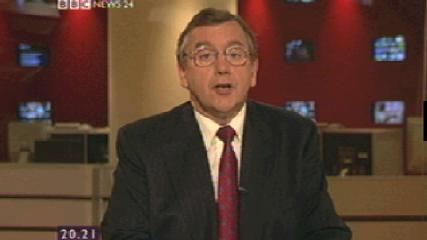 This can be especially annoying if the broadcaster has already zoomed up 4x3 material to a 16x9 frame as often happens on News 24. Picture quality can deteriorate further and important parts of the image can be lost. Bear in mind that all these pictures include overscan, so when actually viewed on a TV, the image to the left would be cropped further and it is unlikely that the DOG or clock would be visable. Whether this is a good thing is open for debate...
This can be especially annoying if the broadcaster has already zoomed up 4x3 material to a 16x9 frame as often happens on News 24. Picture quality can deteriorate further and important parts of the image can be lost. Bear in mind that all these pictures include overscan, so when actually viewed on a TV, the image to the left would be cropped further and it is unlikely that the DOG or clock would be visable. Whether this is a good thing is open for debate...
